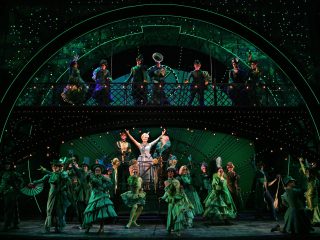Do you know your sprechstimme from your recitative, or your buffa from your seria? Don’t let the strange opera terminology scare you off! Read this guide to opera terminology. and learn how to bluff your way through any conversation at the after-show drinks.

Recitative
This is operatic conversation. In many operas, the recitative is where the story happens, and it is basically musical dialogue. The conversations are notated, but any accompaniment is sparse, and the rhythms are often dictated by the rhythm of the spoken language.
Sprechstimme or Sprechgesang
Translation: ‘speaking voice’. It is a type of vocal production which is halfway between speaking and singing, where the voice does not take on a full operatic quality, but it is more rhythmic and musical than a simple speaking voice.
En travesti
If a role is described as being performed ‘en travesti’ it indicates a role where the character’s gender does not usually match the performer’s gender. This is most often used to describe what we now would call a ‘pants’ or ‘trouser’ role, such as Cherubino in The Marriage of Figaro, which was written for a female soprano to play the role of a male character. There are also such things as ‘skirt’ roles, although they are far less prevalent. The practice of switching genders in opera is one that has persisted since the very origins of the form…find out more in our blog post ‘Who wears the pants’
Sitzprobe
Often shortened to ‘sitz’ this is a term also used in Musical Theater. The literal translation is ‘sitting rehearsal’, and it is usually the moment where the singers and orchestra meet for the first time. The music for the opera is rehearsed in full, with no staging; the singers ‘sit’.
In big opera houses, this is usually quite an event, and singers often dress up for the occasion. After weeks of building characters and running around rehearsal rooms, with the accompaniment of the rehearsal room piano, the singers now have this chance to return to the score, and to delve deeply into the full support of the orchestra. In Italian it is known as the prova all’italiana.
This is easily the most Instagrammable rehearsal. I mean, if you didn’t #sitzprobe, were you even there?!
Bel canto
Translation: ‘beautiful singing’. This term is used a lot, and thrown around all the time by people talking about singers, although it is difficult to pinpoint what is ‘bel canto’ actually is.
It refers to a musical movement of the baroque period, led by composers such as Handel, which required singers to perform incredibly virtuosic writing. This was then imitated and built on by composers of the 18th and early 19th centuries. In a chicken-and-egg type origin story, out of this movement came the Italian school of singing, which is referred to as the ‘bel canto’ technique, and is considered by some to be the way that all singers should sing.
The term itself has always had a nostalgic quality, and it is often used as a shorthand for saying ‘singers just don’t sing like they used to’, or the equally often used, ‘back in my day…’. Arguments as to what is considered a correct bel canto technique, or which singers epitomise the term ‘bel canto’, have been going on, probably, since the dawn of opera, and will continue for many years.
Associated terms include; chiaro-scuro, appoggio, passagio, portamento, messa di voce, and many others. Many of these are legitimate terms still used by teachers and singers in the opera world, as they refer to important aspects of the voice and vocal technique.
Fach
Not an expletive! A fach is a voice category. Voices can be categorised beyond the well-known terms of soprano, mezzo-soprano, contralto, countertenor, baritone, bass-baritone, and bass. No two sopranos are alike, as no two baritones are alike, so the fach system was invented as a way of describing a voice in a more detailed way. It also defines particular characteristics of the voice, and can be used to find roles which will suit a particular singer who identifies with a particular fach.
Terms which are used to describe a person’s fach can include lyric, dramatic, helden, spinto, coloratura, soubrette, buffo, character, haute-contre, full, light, profundo, cantante, and several others. There is so much to be said here that this is definitely a project for another blog post!
For an idea of the differences, compare this clip of tenor Javier Camarena in La fille du regiment. He sang the famous aria ‘Ah, mes amis’ which has 9 high tenor Cs in it, then when the audience wouldn’t stop applauding, he did it all over again – 18 high Cs! This role suits a lyric coloratura tenor.
In contrast, here is tenor Aleksandres Antonenko singing Otello’s aria from Verdi’s Otello. This role is more suited to a dramatic or helden tenor.
Both tenors, but distinctly different.
Opera buffa / Opera Comique / Singspiel
These are all types of opera comedies, which are written in different languages. They are usually situation comedies, which involve real people getting involved in farcical events. They nearly always have some form of dialogue, although in opera buffa this would most likely be in the form of recitative.
Buffo
The term ‘buffo’ is often used to describe a character role, sung by a bass or bass-baritone. He is often an older character, and quite often someone who gets into capers in comic opera. The similarity with the English word ‘buffoon’ is a good way of remembering this. Buffo specialists need great comic instincts, and great skills in patter.
It is also possible to have buffo characters in other voice types, and the term buffo tenor is sometimes used, but most commonly it refers to a bass voice.
Patter
This could be considered ‘rap’ of opera. It is most often used in Italian operas, particularly in opera buffa. It is a technique where singers have a lot of text to deliver on very fast notes, usually with nowhere to breathe! When done well, these operatic tongue twisters are spine-tinglingly exciting.
Here are two buffo characters performing a patter duet from Don Pasquale. Check out around 3.40 when Luca Pisaroni, playing Don Pasquale really takes off, followed soon after by Thomas Hampson, as Doctor Malatesta.
Opera Seria
The opposite of opera buffa, can be thought of as ‘serious’ opera. Someone usually dies, and there is often a king or a royal family involved.
Verismo
Verismo was a movement in opera that decided to go against all of the grand stories of kings and queens, and instead to take moments from the lives of real people. One of the most well-loved operas La boheme fits into this category. The movement concerned itself with presenting the ‘truth’ of life (in italian vero = true), so we have stories about ordinary people, people in poverty, families and friendships, and we see them living out the harsh realities of life.
And finally: Toi, toi, toi
If you are wishing an opera singer a good show, never say ‘break a leg’. The term that is used in opera is ‘toi, toi, toi’. There are many theories to why this is used, some think it is an echo of spitting the bad phlegm away. Others think it comes from an old hex on the devil. Whatever the origin, it is the prefered way to wish your singer friends a great show. Although, you can also say ‘In bocca al lupo!’, ‘In the mouth of the wolf!’













